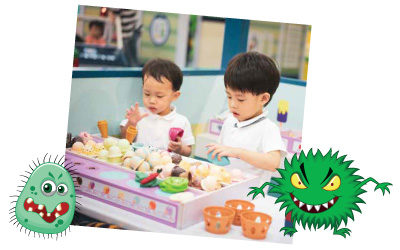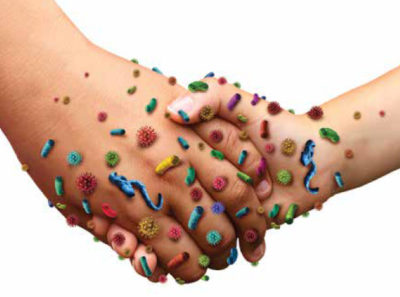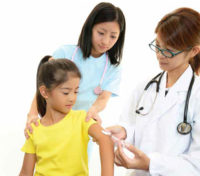The country was alarmed when there was a steep rise in hand, foot and mouth disease (HFMD) among children in July and August this year. More than 50,000 cases were reported, a 120% increase compared to last year.
In Europe this year, measles cases have reached a record high. The World Health Organization (WHO) reported that more cases were recorded in the first half of 2018 than any other 12-month period this decade.
Both outbreaks severely affected children, causing hospitalisation and deaths. Schools and kindergartens in Malaysia were forced to close after many students were infected with HFMD. Kids are vulnerable as their immune system is still developing. They are very curious and love to explore their surroundings, exposing them to germs that can cause infections. Serious complications can result from infectious diseases, so it is crucial for parents to ensure the well-being of their children by taking steps to prevent infections.
Infectious disease 101
It is a question that arises whenever an outbreak occurs: why does it keep happening every year? Last year, diphtheria was on the rise, while this year, it was HFMD. Dengue fever, on the other hand, is a constant threat in many hot spots in Malaysia. Who knows which infectious disease will be in the headlines next year?
According to Dato’ Dr Musa Mohd Nordin, a consultant paediatrician and neonatologist, the key to answering this question is to know what infectious diseases are. “Infection happens when germs invade the body and start to multiply, causing the body to react. Illnesses that result from infections are called infectious diseases,” he said. Non-infectious diseases, such as cancer or diabetes, are caused by other factors like genetics, lifestyle and environment.
Infections can be caused by different kinds of infectious agents or pathogens. “The usual culprits include bacteria, which cause diseases like strep throat and urinary tract infections, and viruses, which result in diseases like HIV/AIDS and influenza,” he said. Other microbes such as fungi, protozoa, and various parasites can also cause infectious diseases.
“There are many types of infectious diseases and each has its own symptoms. But generally, when you are infected, symptoms such as fever, diarrhoea, cough and lethargy are common,” he explained. However, an infection does not necessarily lead to illness. “A person may be infected without showing any symptoms. In this case he is considered an asymptomatic carrier,” he added. There may also be cases whereby the symptom is latent and will only appear in later stages of the disease.
Spread awareness, not germs
Infectious diseases, also known as transmissible or communicable diseases, can spread widely and turn into outbreaks mainly due to a lack of awareness or concern among the public. “There are still many people who are not aware of the different ways infectious diseases can spread,” said Dr Mary Joseph Marret, a consultant paediatrician. “Some parents still send their kids to school even when they are sick. They may say that there is no one to take care of their sick child, but doing this will expose other kids to infection,” she added.
Germs can spread in a number of different ways. Different pathogens have different mechanisms of spreading infection. “Infectious diseases that spread from person to person are called contagious diseases. These include transmission via direct physical contact, like kissing and touching, and droplet contact when someone coughs or sneezes,” she explained. “Using or touching something that was used by an infected person, like sharing a straw or toothbrush, may also spread infection,” she added. This happens because body fluids of an infected person such as saliva and nasal discharge contain the virus or bacteria causing the infection.
“Infectious diseases can also spread from animal to human. For example, you may get a toxoplasmosis infection if you are not careful when handling your cat’s litter,” she said. Some diseases such as dengue or malaria are spread by vectors such as mosquitoes. “The vector does not cause the disease but passes the pathogens from one host to another,” she added. Foods or drinks, which are not properly cooked or contaminated, are also potential sources of infection, as many pathogens such as E. coli may be present in the food.
Being aware of the risk factors is also crucial in stopping infection. “You are more likely to get sick if your immune system is not functioning well or is still not fully developed, like in young children,” she commented. “Older people have a higher risk of getting infected due to pre-existing diseases. Individuals with diseases that affect the immune system such as HIV/AIDs may be more prone to infection. Another group of people at risk are those receiving treatments that can suppress the immune system, e.g. patients undergoing chemotherapy or radiation for cancer.”
Prevention is key
Knowing how infectious diseases are transmitted and who are most likely to be affected are helpful in planning strategies to stop infectious diseases, and consequently, control outbreaks. Better care can be given to people at risk, and appropriate steps can be taken to prevent infection. One essential and obvious way of preventing infection is to practise proper hygiene.
Hand-washing may seem trivial, but it is the best form of protection from germs. “Germs on your hands can infect you when touching your nose, eyes, or mouth. Teach your kids to wash their hands with soap and water thoroughly for 10 to 15 seconds before and after preparing and eating food, after coughing, sneezing or using the toilet, and after playing outside or touching a pet,” advised Datuk Dr Zulkifli Ismail, a consultant paediatrician and paediatric cardiologist. But are antibacterial soaps necessary? “Studies have shown that antibacterial soaps are no better at cleaning dirt than regular soaps. In fact, the overuse of antibacterial soap may contribute to the rise of antibiotic-resistant bacteria,” he explained.
Another aspect of hygiene is to practice sick-day etiquette. “If your child is sick, let him stay at home. Encourage him to cough or sneeze into a tissue or handkerchief, instead of with his bare hands. Germs are more likely to spread by hands than through the air. Remind him not to share his personal items, like water bottle, eating utensils, toothbrush or towel. If it is necessary for him to go out, he should wear a face mask if he is unwell,” he advised.
“As the consumption of contaminated food is another way to become infected, safe food preparation and storage is a vital part of prevention,” said Dr Mary. She shared some tips:
- Wash your hands and make sure the kitchen surfaces are clean when cooking.
- Before eating raw fruits and vegetables, wash them thoroughly.
- Make sure meat, poultry, and seafood are well cooked.
- Never eat raw or undercooked eggs.
- Cook frozen food right after it is defrosted.
- Do not leave leftovers at room temperature for extended periods of time.
- Utensils and surfaces used in the preparation of raw meat, poultry and seafood should never come into contact with cooked food.
It is also good to schedule some time to do housecleaning. “Regularly clean floors, bathrooms, carpets, and windows with water and detergent. If someone got sick recently in your house, use disinfectants to remove germs on surfaces and items like kitchen counters, tables, toys, dishes and utensils,” she said. When travelling out of the country, take extra precautions. She added, “Consult your doctor if you need any special vaccinations like yellow fever, cholera, or typhoid for the country you are visiting. Find out about food and water safety in the country, and take steps to prevent insect bites.”
On vaccines and antibiotics
When diphtheria cases re-emerged in recent years, there were concerns that it might be due to the increasing popularity of the anti-vaccination movement in the country. Misinformation and lack of education might have led to this situation, causing a drop in immunisation uptake. Thus, the protection provided by herd immunity against vaccine-preventable diseases may be compromised, leading to possible outbreaks. “The best line of defence for these infectious diseases is vaccination. It is mandatory for parents to ensure their kids are vaccinated according to the National Immunisation Programme,” Dr Musa said.
Apart from the anti-vaccination movement, the prevalent misuse of antibiotics can also ultimately lead to more frequent outbreaks. “Antibiotics have been very beneficial in fighting bacterial infection since the development of penicillin. But the overuse and misuse of antibiotics have contributed to antibiotic resistance in some bacterial strains,” Dr Musa explained. “Antibiotics should not be used as a treatment for viral infections like the flu. Take antibiotics as prescribed, and always complete the treatment. And never use leftover antibiotics or ones prescribed to others,” he advised.
National Immunisation Programme (NIP)
Vaccines covered by NIP
- BCG (Tuberculosis)
- DTaP (Diphtheria, Tetanus, Pertussis)
- Hepatitis B
- Haemophilus Influenzae type B
- IPV (Polio)
- MMR (Measles, Mumps, Rubella)
- Human Papillomavirus, HPV (girls only)
- Japanese Encephalitis (Sarawak only)
Recommended vaccines that are not in NIP
- Pneumococcal
- Meningococcal
- Rotavirus
- Chicken Pox
- Hepatitis A
- Influenza
A final word
Children are prone to infectious diseases since their immune system is still developing. Some infectious diseases may be mild and resolve on their own, but some can be devastating and even fatal. “Keep your kids safe from infection by practising hygiene as a habit in your family. Protect them from vaccine-preventable diseases by following the National Immunisation Programme accordingly. Practise healthy living by doing regular exercise and having a balanced diet to boost the immune system,” Dr Zulkifli concluded.
By Dato’ Dr Musa Mohd Nordin, Consultant Paediatrician & Neonatologist; Dr Mary Joseph Marret, Consultant Paediatrician; Datuk Dr Zulkifli Ismail, Consultant Paediatrician & Paediatric Cardiologist.












Comments